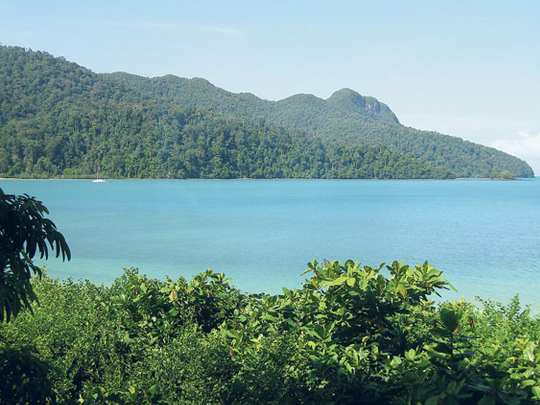
It would be all too easy to stay on your sunbed staring at the gentle curve of the Andaman Sea that stretches between the luxurious Andaman Hotel and the exclusive Datai further down the beach, with coconut water mid-morning, cappuccinos and a good book later on, followed by fresh seafood lunch at the live cooking café and typical Malay dinner at the exquisite Gulai House further along the bay. But get up, get out and look around Langkawi! You'll be glad you did.
On checking into our hotel we were told there would be a nature walk at 8am the following morning. Did we want to book on to it, as there were still other places to see? As Malaysia is four hours ahead of Dubai, that would mean getting up far too early, and we were already tired from the journey and I could go on, "Yes please, good idea, four of us, two adults and two children, oh and a wake up call as well please, both rooms!"
Exotic creatures
The nature walk, led by Usman of Junglewala Tours, was free for hotel guests. We were a group of 12 adults and children, a variety of nationalities, all wearing sun hats and shorts, carrying bottles of mineral water and eager to walk. The tour turned out not be so much of a trek, rather more a lesson in how to look at things around you on the island. The first thing we saw was a perfectly camouflaged, sedate flying lemur that sleeps for up to 12 hours a day, and to the surprise of our guide, not one of us could answer correctly that this creature was more closely related to a monkey by its DNA, than to bats or wild squirrels as we may have wrongly suspected. (We hadn't yet left the lobby of the hotel.) We continued out of the hotel and were educated about how to distinguish whether a bird was in fact a hornbill (flaps four times and then does a big glide) or a white bellied sea eagle (from which Langkawi gets it's name)
Monkeys going bananas
We were greeted by troupes of dusky-furred, white-faced monkeys, and were told again it was strictly forbidden to feed these creatures who were now quite used to humans. They seemed to be happy helping themselves to the green bananas growing abundantly on the surrounding trees. This was OK because the bananas were strictly not for human consumption, like the plentiful young figs which would result in trips to the toilet every 20 minutes. Only an antidote of fresh coconut water would provide relief.
Usman went on to show us how to use a Kahang leaf as a carrier bag complete with its own handle. Usman used to be a snake handler and regaled us with tales of how to extract poison from cobras and vipers. Unlike on TV, don't suck and spit out the poison; it's better to push down the skin away from the bite and extract the poison with a special mini skin hoover designed especially for the purpose.
If you want to go on a longer tour, get a taxi to Jetty Kilim in the north-east of the island (about 20 minutes along the serene coastal road) and hire a private wooden sailboat with guide for around 250 ringgit (Dh274) for four persons (much cheaper than going with a tour company). We had no idea what to expect but gothic horror awaited us at the first stop of this extensive mangrove tour in the form of the Bat Cave. A multitude of small, ghoulish, jet black bats clung on to the moist ceilings of caves filled with ancient stalagmites and stalactites. The small torch you are offered at the entrance is a must.
I was initially annoyed at Adi, our boatman and guide, for reminding us to buy peanuts for the monkeys as we knew not to feed them, but apparently this was an exceptional occasion. I have never before seen monkeys swim but that is precisely what they did, not quite into the boat but near enough. They squabbled and fought over who got the precious nuts, to the delight of both our children who needed extra hands to throw nuts and take pictures at the same time!
Marine life up close
A short ride down the river brought us to the Floating Fish Farm, which comprised a series of reinforced wooden rafts that surrounded smaller open underwater tanks that in turn housed a variety of sea creatures. We handled blue blooded horseshoe crabs, peered at reef sharks and stingrays and admired groupers jumping for blobs of mashed up bread. For me the most interesting bit of the tour was the meandering journey the boat took through the narrow mangrove forests. The hardy trees helped save much of Langkawi by causing a sort of strong breakwater when the 2004 tsunami hit. The mangroves themselves are a dense system of plants, bushes and trees that grow in salt water, which in turn provide homes to shrimps, prawns, crabs and fish. The root system itself is a magnificent example of natural engineering and comprises intertwined branches, some of which produce berries and a spear tipped elongated bean-like fruit which Adi encouraged us to pluck and plant in the muddy soil at the end of our trip. That helps propagate this important ecosystem for future generations. We decided we would return to see the results.


